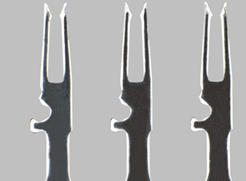Electronic devices do not function until electronic parts and elements are bonded and assembled, when solderability is a key factor. In other words, together with being whisker-free, prior plating with good solder wettability is a requisite condition for facilitation of soldering. Here, the solderability of recent lead-free solder plating is introduced in contrast to conventional tin-lead solder plating.
| Type of plating | Characteristic value | Uses |
|---|---|---|
| Tin-lead alloy plating | - Sn-10Pb alloy plating Solderability (excellent), whisker suppression (excellent) |
Electronic parts, semiconductor parts, and electrical machine parts |
Tin-copper alloy plating |
- Sn-3Cu alloy plating Solderability (good), whisker suppression (good) |
|
Tin-bismuth alloy plating |
- Sn-2Bi alloy plating Solderability (good), whisker suppression (good) - Frequently used for legs of lead frames |
|
Tin-silver alloy plating |
- Sn-3.5Ag alloy plating Solderability (good), whisker suppression (good) |
|
Reflow tin plating
 |
- Solderability (good), whisker suppression (excellent) - While the alloy compositions of various types of alloy plating greatly change depending on plating conditions, single plating like reflow tin plating is highly reliable precision plating having no composition variations. Recently, reflow specifications of semigloss tin plating have increased more than alloy plating. |

Reflow tin plating